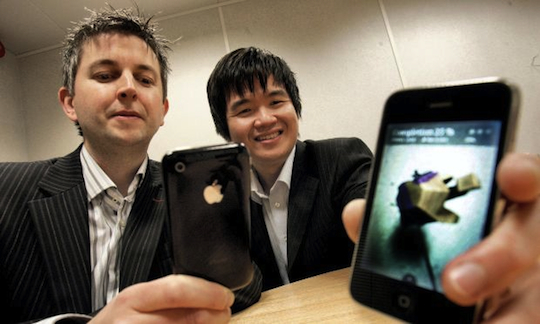
This is a guest post by Phillipe Bosher, an 18 year old from the UK who is headed for Oxford University.
At the Games Developers’ Conference 2009, Neil Young, head of ngmoco, held a talk entitled “Why The iPhone Changed Everything.” In it, he spoke of how the iPhone revolutionised not only the handheld gaming market, but also the way people played video games forever. Some were convinced by his impassioned speech; others felt that it was purely the ramblings of a man trying to succeed in a tough market.
Recently, I was able to meet with Joe Wee and Chris Byatte, both Directors at Chillingo, Carmen Pearson, Global Head of PR and Communications at Chillingo, and David Amor, Creative Director at Relentless Software. Over the course of two interviews, I asked them about the iPhone, the way they approached development/publishing on the iOS platform, and whether they agreed with Young’s 2008 talk that the iPhone changed everything.
Founded in 2002, Chillingo once developed video games for the handheld market, selling them through their clickgamer.com web portal. Now, however, they focus on publishing games and, in their own words, “polishing games from a seven to a ten.” If you’ve ever played Angry Birds or Cut the Rope, you know they’re not kidding.
“We saw [the iPhone] as a revolutionary device,” stated Chris Byatte. “It offers easy access direct to the consumer, and ever since we began focusing on it, it’s been a rocket trip on the back of Apple.” Joe Wee agreed: “[Everything] changed with the iOS, and with the iPhone. It had great form factor, a great new innovative multi-touch screen, and great new hardware that allowed for a whole new breed of developers to develop content on. They got rid of the need to create different builds for different handsets, because you were only making content for the one phone. They gave developers a direct channel to consumers, through the App store. And they gave developers 70% [of the revenue]! [With older handsets,] if you managed to squeeze 50% revenue share from a deal, that was a good deal! *Laughs* And the only barrier to entry [on iPhone] was: get yourself an iPhone, pay $100 for the development kit, and you can start creating content. This changed the entire industry.”
David Amor, Creative Director at Relentless Software, preferred to think of the iPhone’s better qualities from a consumer’s perspective: “There’s so many things competing for our attention and, personally, my life has become a bit more fragmented into lots of little bits of time. I think the iPhone works well for that because, well, it’s always in my pocket. Whenever there’s a bit of downtime, between doing one thing and another, I can have a little play – it really is good for those little fragments of time.”
Of course, the most common criticism levelled at iPhone games is their expendability. ‘Hardcore gamers’ will argue time and again that, if you’re playing a game on an iPhone, it’s not a real gaming experience. “They’re just different types of games.” Byatte offers, “I do think that there is always a place for these handheld consoles though – 3DS, for example. It’s really driven by content. If a great game comes out for a platform, I’ll probably go out and buy that platform. I think the trend is definitely towards the iPhone though, for sure. Market share is increasing.”
Past successes only serve to aid Chillingo’s confidence: “At BAFTA, we won the best handheld game for Cut the Rope.” Wee reminds me, “That’s in a category that’s directly against the PSP and DS, but the iOS came out on top! That’s a testament to something very new in this industry: the fact that the iOS is recognised to be a handheld gaming device. There was a piece of research that came out last August, predicting that the iOS would be the biggest handheld gaming device by the end of 2011. It was already No. 2 after [the DS]! The trend is definitely moving that way.”
Amor agreed, and offered his own explanation as to how the difference between the types of video games was exemplified: “We know that the way people played Buzz! (Relentless Software’s arguably most popular series), or at least, the way we designed it to be played, was: four players in the living room, after a couple of drinks, in the evening. On iPhone, because of the platform, the way it’s used, and the people using it, it’s going to be different.
But how could they cater to the different types of gamers? Wee disagreed with my entire notion of a ‘divide’ in the gaming community: “In our experience, bringing out super-casual, mass-market games: Angry Birds is a great example, where it appeals from 7 year olds to 77 year olds. It unlocks the hidden gamer in everybody. These bite-size chunks of games – they define a whole new generation of gamers. People who don’t think that they’re gamers are actually gamers! They’re playing the game! There’s a shift from the older, more hardcore… geeks playing stereotypical games, to something that’s more socially acceptable now. It’s just ‘Oh, I’m playing a game on my iPhone. It doesn’t make me a geek; actually, I’m super cool.’”
Carmen Pearson, Global Head of PR and Marketing at Chillingo, agreed: “We’re also finding a convergence between these hardcore gamers, who do carry around smart phones, such as the iPhone, who are playing these EA Mobile titles. Dead Space is a good example. There’s a lot of titles like that that are being translated onto the iPhone, and you can find casual gamers, who don’t play a lot of games, who are playing that as well. So it kinda goes both ways, we’re seeing.”
But what about development? How does the iPhone’s radically different perspective affect the design process? Amor explains: “A huge advantage of the iPhone is that you can guarantee, at some point, it will be connected to the internet. We can use that to make a better game. As a company, [when designing upcoming iOS title ‘Quiz Climber’] we can make our best guess as to what’s an easy question and what’s a hard question, but the best way of finding out for sure is to see how people are answering it. If everybody’s getting it wrong, it’s probably a pretty hard question!
“Like any other developer, we have the ability to update, to increment the version number, to include new features. But we’re also making sure that we can do this invisibly as well. Inject new questions, without making people go to a store and update. For some things, like a big release, you’ll probably have to update a new version, but there are plenty of things we can do without forcing people to do that.”
Wee explained the process from a publisher’s perspective: “Although we don’t develop the games, we do have production teams that work very closely with the development studios. If you like, we’re like the virtual producer. We help indie developers depending on what stage the game is by the time it gets to us. Sometimes it’s at the concept stage; sometimes it’s almost done. We then inject all the knowledge that we have about what makes a game great, and turn that 7 into a 10. All the extra polish that it might need – Angry Birds is a great example. When it came to us, we had our producers sit down with the Rovio guys and say “Ok, let’s bring out more character!” The original Angry Birds, I remember, didn’t have the birds dancing around before you shoot them, the pigs didn’t grunt, and there was no trajectory of the line – there was no learning curve, there was no progression. So we added all that in! And that helped turn it into what it became.
“That’s just on the production side. After that, there’s the QA, the promotional side, building hype around games… it’s an iterative cycle, because the whole concept of games as a service is so real in the App Store world. When you launch a game, it’s no longer about moving onto another game – because, great, the first one is out there – it’s about listening to what our users are saying about the game in reviews, and then a week later, we’re already planning updates. We’re always servicing the same customer, and bringing them back to play more of the game.”
Do companies actually take the user reviews into account then? Pearson wasted no time in explaining Chillingo’s ethos: “That’s the one thing we really pride ourselves in. Some other publishers/developers, when they see reviews hit the Internet or App store, they’re like ‘Alright.’ and they never update their game. We work on our updates instantly! I recap all the coverage we get, all the feedback, and feed that back to the developers instantly.”
“Yeah, Carmen’s the best,” Byatte laughs, “[User reviews] are essential. Sometimes, we’re working on an update within minutes.” Pearson continued: “That’s the beauty of working with indie developers on the iOS platform. They don’t have these great egos, they want to give the consumers what they want. It’s their baby, and they want to make sure their baby looks as desirable as possible.”
Aside from user reviews, developers are also able to instantly access data on how people are playing their game. When asked about it, Relentless’ Amor laughed: “It’s both a blessing and a curse. [With Buzz], we sent out a disc, and you say “Ha! The world is having a great time with our game” and you sleep easily at night. The truth is, you never really know. I’m sure that, if I go around someone’s house and they’re playing one of our games, I’ll wince at some of the decisions we made that we should’ve attended to. It’s a blessing in that, naivety is bliss on a disc, and it’s a curse insofar as you do miss things.
“Conversely, on iPhone, you get to see exactly what people are doing. Which means that, every day, you’re saying “Oh! They’re getting stuck on this! We thought that would be easy!” But at least you get to fix it. *laughs*”
So far, so good – everyone seems to be happy with the iPhone as it is. But it’s certainly likely that the iPhone will see a new iteration release this Fall – what would the publishers and developers like to see from it? Byatte seemed happy with how things currently are: “I think it’s pretty much rounded off, as a hardware item. It’s incredible. But Apple are always adding new, innovative things, and whatever they add, we’re going to utilise it to its full potential.”
The engineer in Wee couldn’t help but speculate, however. “I’ve got a wish list of what would make the perfect gaming device. Definitely, for a multi-touch interface, having some tactile-based response system would be perfect. *Grins* Imagine shooters – feeling some tactile feedback as you shoot!”
Amor expressed interest in a new iPhone, but felt Apple’s larger mission was far more interesting: “I’m more interested in what will happen when they connect something to a bigger TV. To date, they’ve got a desktop platform and a handheld platform – the iPhone – so what happens when they flick a switch, and announce Apple TV 2, where you can play games on the TV?
“To me, it’s not even about the technology. Even though there’s some great technology in the iPhone, I don’t think that’s the biggest thing that Apple brought [to the table]. It just opened up gaming to a ton more people. People were comfortable playing games, and developers could make games really easily; so even though I’m sure that whatever technology they eventually do connect to a TV will be great, what I’m more interested in is how Apple as a company deal with that market. They’ve changed pocket gaming, so it could be interesting to see what they do with TV gaming.”
There ended the conversation. We covered a lot during the thirty minutes we spent talking, but if one thing’s for sure, it’s this: when it comes to mobile gaming, the iPhone really did change everything.






